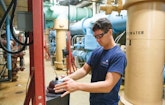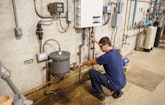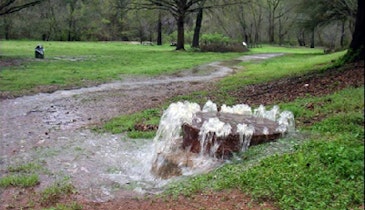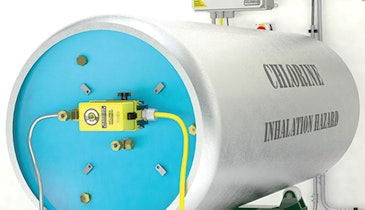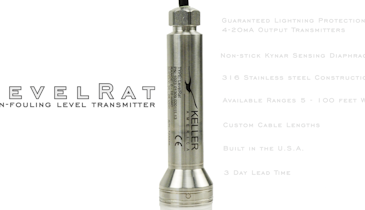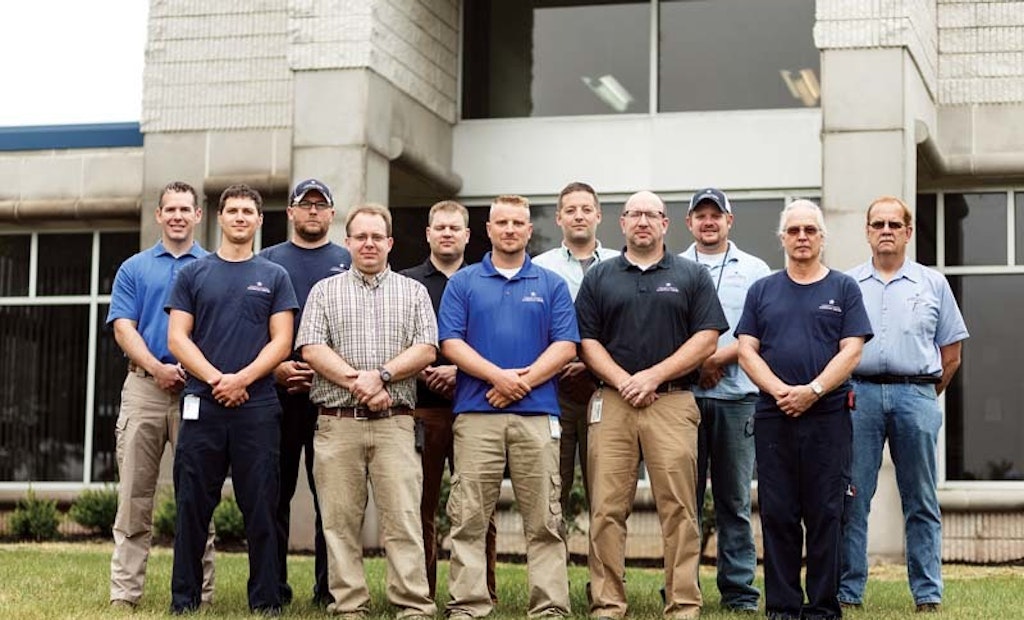
Interested in Tanks?
Get Tanks articles, news and videos right in your inbox! Sign up now.
Tanks + Get AlertsTeam members at the G.C. Smith Treatment Facility and Operations Center have faced wildly fluctuating turbidity from farm runoff into the source water creek. They’ve fought their way through snowstorms and floods.
They’ve overcome those obstacles and more and continue to excel, striving to provide the best water in the state to 19,000 customers, including the Hershey Foods chocolate factory and Penn State Milton S. Hershey Medical Center.
The plant in Hershey, Pennsylvania, started working with the Partnership for Safe Water in 1996. In pursuing the Presidents Award in 2014, the staff had already taken steps to improve plant performance, including a switch from alum to a ferric chloride/polymer blend to improve filter runtimes and turbidity.
Justin Brame, production supervisor, compiled the necessary turbidity data for the Presidents Award, with help from Branden Leaphart, SCADA programmer. “We knew we were eligible,” says Brame. “Our turbidity numbers were incredible by industry standards, and we had met the Phase IV Partnership criteria for years. But we just hadn’t had the time to crunch the numbers and complete the paperwork.”
The plant’s combined filter effluent turbidity during that period was 0.03 NTU, and settled water turbidity was 0.50 NTU. “The team worked diligently to achieve and maintain these standards, and I knew I needed to find the time to make sure they were recognized for their efforts,” says Brame. “I was glad to see all that work pay off when we received the Presidents Award in 2015.”
Major upgrade
The G.C. Smith plant (11 mgd design, 7 mgd average) is owned by Pennsylvania American Water and is named after former president Gerald C. Smith to honor his 47 years with the company. The plant was placed in service in 1992.
Source water is from Swatara Creek, but the plant can switch to Manada Creek to supplement that supply. On Swatara Creek, water is withdrawn into a concrete intake and through a traveling or stationary screen (FMC Technologies) before being pumped to the plant.
A ferric/polymer blend coagulant is added, along with caustic soda for pH control. Chlorine, potassium permanganate, powdered activated carbon and cationic polymer are added as required. The water passes through a static mixer, then into a mixing chamber. From there, it enters one of five distribution chambers where chlorine can be added if necessary.
Next, the water enters a vacuum chamber where it is lifted and released, creating a pulsating action in the clarifiers. The water then enters one of five Superpulsator clarifiers (SUEZ). The clarified water flows to a perforated pipe leading to a flume for chlorine addition. From there, it passes through five multimedia filters and is piped to a chamber where chlorine, zinc orthophosphate and caustic soda are added. It then enters a 2-million-gallon clearwell.
An $8 million upgrade in 2011 added the fifth Superpulsator to increase capacity from 9 mgd to 11 mgd. It also added an ammonia feed system that allowed the conversion from free chlorine to chloramine disinfection. A chlorine scrubber system (Purafil - a Filtration Group Company) was installed for safety reasons.
Flashy creek
Fluctuating raw water conditions keep operators on their toes. “As long as we are diligent, our water can be fairly easy to treat,” says Brame. “But raw water turbidity can change from 5 to 500 NTU in a few hours because of the large number of farms in the watershed. We are fortunate to have operators who are very knowledgeable and dedicated to providing the best possible product for our customers regardless of the creeks’ conditions.
“It seems like today, more than ever, the creek source is flashy. The small to average rain events have been replaced with huge rain events, floods, huge snow events, and droughts. This makes water treatment challenging. But it appears to be the new norm, and we have to be prepared for it.”
Plant operators try new chemicals, technologies and lab equipment to help them understand source water conditions and treat them effectively and efficiently.
“We have been working hard on updating our source water protection plan, so we have a better understanding of our watershed and the risks and hazards upstream of our raw water intake,” says Brame. “We meet with local officials, schools, clubs, associations and customers to get the word out about protecting and improving our watershed.”
Having an automated system helps. According to Brame, the programming for the SCADA system from Allen-Bradley (Rockwell Automation) is among the best: “The programs that the SCADA teams developed over the years, and what Branden Leaphart maintains and improves, have made the Hershey plant one of the most automated facilities at American Water.”
Tracking turbidity
Brame was water-quality supervisor when the plant team began pursuing the Presidents Award. In compiling turbidity data, he was required to focus on raw water, settled water and combined filter effluent water turbidity at 15-minute intervals for 12 months.
“We were also required to provide the 15-minute turbidity data for each individual filter during that 12 months,” says Brame. “For the last requirement, the Partnership states that the turbidity following a backwash may be greater than 0.10 NTU for no more than 15 minutes. After evaluating all this data and preparing it for submission, we knew we met and exceeded all the criteria for the award. We even tightened many of our own plant standards regarding turbidity. We just wanted to keep improving and making things better and safer.”
The switch in 2010 from alum to a ferric/polymer blend (PVS Technologies) greatly improved filter runtimes and turbidity. “NTUs are well below 0.03 most of the year, and filter runtimes are 120 hours without exceeding headloss parameters,” says Brame. “In the past, there were times when the filters could barely make it for eight hours before exceeding head loss regulations and needing to be washed.”
Stormy weather
The team has faced its share of bad weather over the years. A historic flood in 2011 and a snowstorm in 2015 presented major challenges. “Last winter, we received 38 inches of snow from one storm,” Brame recalls. “I scheduled two operators to stay at the plant and rotate shifts to keep the plant covered.” The operators ended up staying at the plant for four days. Fortunately, the facility keeps cots and emergency food and drink on hand.
“We have a very dedicated staff, and they take a lot of pride in what they do,” says Brame. “It seems like a job at this plant is a stepping stone to advancement. I was an operator here and then moved into management.” Several operators have moved on to management positions over the last few years.
Some staff members who assisted in winning the Presidents Award have since moved up within American Water: George Cradic, fleet manager in the Mechanicsburg office; Robert Troutman, production supervisor at the West Shore plant in New Cumberland; Toby Jones, backflow specialist at the Hershey plant; and Jon Prawdzik, superintendent in the Mechanicsburg office.
Besides Brame, who has been at the plant for five years, operators include Michael Barger, Richard Bitting and Terry Patrick, a 34-year veteran. The plant is staffed with one operator for 12 hours each day. The operators work one week on, one week off. Barger also handles maintenance, as does 25-year veteran Dale Skinner, maintenance services specialist.
The operators are responsible for all process control decisions, sample collection and laboratory testing, and routine maintenance. Brame says their greatest strength is the ability to self-motivate: “They see what needs to be done without my telling them. They go above and beyond, and this sets them apart.”
Future challenges
Although the Hershey area is growing fast, a 2011 study showed that the plant’s 11 mgd capacity will meet population needs well into the future. Brame does expect some challenges, though.
“Water treatment is different than it was 20 years ago, with population increases, stormwater runoff, and the need to keep up with new rules and regulations that seem to change every year,” he says. The plant team continues to monitor for emerging contaminants in the source water and adjusts treatment techniques and technologies to suit changing conditions.
Replacing employees who move up or retire is a concern. Says Brame, “In 1970, many young people entered this industry, and now almost 50 years later they are retiring. Over time, operators gain a lot of knowledge. When troubleshooting a problem, for example, they can say, ‘I’ve seen that before and I know how to fix it.’” That institutional memory isn’t easy to replace.
Perhaps the biggest test will be maintaining the Presidents Award. “The key is to not become complacent, but to ask ourselves every year how we can improve and become more efficient,” says Brame. “It is not an easy award to get, so maintaining it is important.”
Above and beyond
Operators at the G.C. Smith Treatment Facility and Operations Center have weathered some serious storms. In September 2011, Tropical Storm Lee dumped 13 inches of rain on the Hershey area, which caused Swatara Creek to overflow.
Before the heaviest rain arrived, teams from plant owner Pennsylvania American Water began preparing for the worst. They reviewed flood emergency plans, removed critical equipment from low areas, placed sandbags around vulnerable infrastructure, scheduled emergency staff, and filled water storage tanks to the maximum.
The rising creek shut down two of three raw water pumps at the intake building, seriously reducing the source water supply. Normal access to the building was impossible, and the only way to restart the pumps was to enter through the roof.
A helicopter was dispatched to transport personnel, sandbags, pumps and other equipment to the roof. When the crew entered the building via a ladder from the roof hatch, they found the water rising and flowing onto the operating floor.
To protect the electrical switch gear, they set up evacuation pumps and built a cofferdam. Joe Woodward, Pennsylvania American Water field operations manager, and Gary Witmeyer, production superintendent, spent the night on the roof to monitor water levels and keep the pumps running.
By this time, Swatara Creek was at 26.8 feet, far above the flood stage of 7 feet. The next day, the creek began to recede. Team members continued to monitor the situation from the roof until the water receded enough to allow access through the intake building door.
Amazingly, the treatment plant’s finished water quality was never compromised. No boil water advisories were required, and water service continued uninterrupted, thanks to the operators and other staff members who worked around the clock to stabilize and protect the water system.

